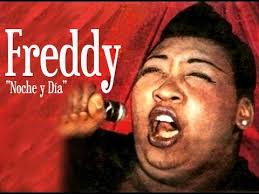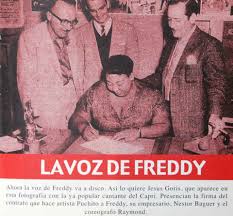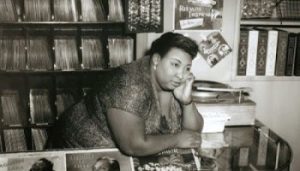 LA FREDDY, MAS CONOCIDA COMO “LA VOZ DEL SENTIMIENTO” O “ELLA CANTABA BOLEROS”. VIDEOS.
LA FREDDY, MAS CONOCIDA COMO “LA VOZ DEL SENTIMIENTO” O “ELLA CANTABA BOLEROS”. VIDEOS.
La Freddy es el seudónimo artístico de la cantante afrocubana de boleros Fredelina García Herrera nacida en la Habana el 11 de noviembre de 1934.
Iba al bar Celeste ―en las calles Humboldt e Infanta― a cantar, a capella, boleros y canciones con un estilo muy personal y profunda voz de contralto. A este bar acudían también músicos, arreglistas y cantantes, pues estaba muy cerca de la emisora Radio Progreso que, noche tras noche, presentaba programas en vivo, ante el público, de orquestas y cantantes de moda (Benny Moré, la Sonora Matancera, la Orquesta Aragón), además de que varias empresas discográficas utilizaban sus estudios para realizar sus grabaciones. Así, se dio a conocer a la bohemia de la ciudad.
Se caracterizaba por su enorme peso (más de 300 libras) y una voz muy potente de contralto que interpretaba temas con gran emotividad.
A los 12 años se mudó para La Habana trabajando en las labores de servicio de familias acomodadas llegando a ser cocinera. Fue su propio patrón quien la motivó a que se presentara a cantar el Bar-café Celeste, en las calles habaneras de Humboldt e Infanta, donde eran frecuentes los cazatalentos, y no se equivocó porque muy pronto debutó en el cabaret del Hotel Capri, en La Habana.
Aunque su físico no era el propio de los cánones de la época para una artista (llegó a pesar 305 libras), su voz cautivó enseguida por su singularidad y sensibilidad interpretativa.
Posteriormente fue muy aplaudida en el cabaret Tropicana. Grabó un sólo disco en 1960 para el sello Puchito titulado “Noche mía” acompañada de la orquesta de Humberto Suárez, con canciones de Agustín Lara, Martha Valdés, George Gershwin, Cole Porter, Piloto y Vera, Ela O’Farrill, etc. Que salió a la venta el 24 de abril de 1960. Fue considerada por muchos la Ella Fittzgerald cubana.
Senobio Faget cuenta que en junio de 1959, Freddy estaba cantando «Cada vez más» (de René Touzet) a dúo con la victrola, cuando apareció, escoltado por una bailarina del cabaret Tropicana, Carlos M. Palma (alias Palmita), abogado, criminalista, promotor artístico y director de la revista Show ―famosa por descubrir talentos nuevos―. Para complacer al doctor Palma, Freddy cantó «Bésame mucho» (de Consuelo Velázquez), «Tengo» (de Martha Valdés), y «Debí llorar» (de Piloto y Vera), acompañada por el cuarteto Los Riveros.
Hay que destacar que el bolero interpretado por mujeres estaba en pleno auge con Elena Burke, Berta Dupuy y Olga Guillot, entre otras.
Uno de los productores del salón Capri fue a comprobar lo que se había escrito sobre ella. La contrató y la hizo debutar en el propio Capri, en la revista musical Pimienta y Sal, junto a Rolo Martínez, el cuarteto Los Faxas y otros. Freddy solo necesitó dos canciones para meterse el público en el bolsillo: «El hombre que yo amé» (de George Gershwin), y «Noche de ronda» (de Agustín Lara).
En 1960 apareció en el programa del circuito CMQ del Canal 6 de televisión, Jueves de Partagás. Cantó junto a Benny Moré y Celia Cruz. Al terminar, Moré se acercó a ella para felicitarla, y Freddy gritó: «¡Ay, Dios mío, perdóname, pero ya puede darme otro infarto! Ahora sí voy a morirme tranquila».
En 1960, Freddy grabó el que sería su único disco de larga duración (Noche y día, Puchito MLP 552). Humberto Suárez hizo los arreglos musicales y orquestales, y dirigió la orquesta en la grabación. El álbum combinó obras sentimentales de autores cubanos y mexicanos, y estándares estadounidenses de jazz, como «El hombre que amo» («The man I love», de George Gershwin), y «Día y noche» («Night and day», de Cole Porter), adaptados al ritmo del bolero con letra en español.
Ese único álbum es conocido también como Freddy: la voz del sentimiento o Ella cantaba boleros.
Freddy se puso de moda y todos querían escucharla, los compositores le entregaban sus canciones y, por suerte, los estudios de grabación se pusieron a sus pies. Y como si se repitiera la historia siempre que tenía un tiempo Pepé Delgado la acompañaba al piano; lo mismo que más de un escritor famoso de aquellos años le dedicó alguno de sus poemas.
A finales de septiembre de 1960, Freddy consiguió su primer contrato internacional con el empresario Hugo Romani, que la llevó a presentarse en Venezuela, en programas de Radio Caracas, en el cabaret Pasapoga y en Coney Island (Caracas), junto a otros artistas cubanos en el espectáculo Carnaval Carioca, producido por el coreógrafo cubano Gustavo Roig, y donde, sin dudas, fue también la sensación del momento.
Después marchó a México, donde trabajó en cabarets. Junto a varios integrantes del espectáculo de Tropicana abandonaron México y pusieron rumbo a Miami, pero Freddy estuvo breve tiempo en esa ciudad. Sin muchos más datos, ni otras fuentes de información que lo publicado por Carlos Manuel Palma en su revista Show, se sabe que la compañía lidereada por Rodney
El Dr. Cristóbal Díaz Ayala dice que “cantaba a cappella, con mucho feeling y con una voz de contralto que sonaba como un contrabajo bien tocado”.
En Freddy se inspiró el escritor Guillermo Cabrera Infante (1925-2005) para el personaje de La Estrella en la novela Tres tristes tigres (1964). Tres décadas más tarde, Cabrera Infante reunió los capítulos en los cuales aparece La Estrella en un libro titulado Ella cantaba boleros (1996).
Aprovechando una gira por Venezuela, México, Estados Unidos y Puerto Rico, se asiló en este último país.
El 30 de julio de 1961 a la noche, apenas un mes después de llegada a Puerto Rico, participó en una de las tertulias que animaba Bobby Collazo hasta la madrugada en su casa. A la mañana le sobrevino un sorpresivo infarto de miocardio y falleció el 31 de julio de 1961, a los 25 años de edad.
La cantante boricua Myrta Silva, quien había vivido muchos años en Cuba y fue para siempre una de las voces más trascendentes de las muchas que pasaron por La Sonora Matancera, se empeñó en ayudar para que Freddy, en su final, tuviera la dignidad que merecía, decisión que apoyaron muchos artistas cubanos que entonces se encontraban en Puerto Rico.
Su tumba se encuentra en el Cementerio Santa María Magdalena de Pazzis (en el Viejo San Juan) franqueada por la de Tite Curet y la de Daniel Santos, el Jefe.
 LA FREDDY, BETTER KNOWN AS “THE VOICE OF FEELING” OR “ELLA CANTABA BOLEROS”. VIDEOS.
LA FREDDY, BETTER KNOWN AS “THE VOICE OF FEELING” OR “ELLA CANTABA BOLEROS”. VIDEOS.
La Freddy is the artistic pseudonym of the Afro-Cuban singer of boleros Fredelina García Herrera, born in Havana on November 11, 1934.
She went to the bar Celeste -in Humboldt and Infanta streets- to sing, a cappella, boleros, and songs with a very personal style and deep contralto voice. Musicians, arrangers and singers also came to this bar, since it was very close to the radio station Radio Progreso which, night after night, presented live programs, to the public, to orchestras and fashion singers (Benny Moré, la Sonora Matancera, Orquesta Aragón), besides that several record companies used their studios to make their recordings. Thus, she made himself known to the bohemian city.
It was characterized by its enormous weight (more than 300 pounds) and a very powerful contralto voice that played songs with great emotion.
At age 12, she moved to Havana working in the service of well-to-do families, becoming a cook. It was her own employer who motivated her to come to sing the Celeste Bar-café, in the Havana streets of Humboldt and Infanta, where the scouts were frequent, and she was not wrong because she made her debut at the Capri Hotel cabaret very soon. Havana.
Although her physique was not typical of the canons of the time for an artist (she came to weigh 305 pounds), her voice immediately captivated by her uniqueness and interpretative sensitivity.
Later she was very applauded at the Tropicana cabaret. He recorded a single album in 1960 for the Puchito label entitled “Noche mía” accompanied by the orchestra of Humberto Suárez, with songs by Agustín Lara, Martha Valdés, George Gershwin, Cole Porter, Piloto y Vera, Ela O’Farrill, etc. It went on sale on April 24, 1960. It was considered by many the Cuban Ella Fitzgerald.
Senobio Faget tells that in June 1959, Freddy was singing “Cada vez más” (by René Touzet) in a duet with the victrola, when she appeared, escorted by a dancer from the Tropicana cabaret, Carlos M. Palma (aka Palmita), lawyer, criminalist, artistic promoter and director of the magazine Show -famous to discover new talents-. To please Dr. Palma, Freddy sang “Bésame mucho” (by Consuelo Velázquez), “Tengo” (by Martha Valdés), and “Debí llorar” (by Piloto and Vera), accompanied by the quartet Los Riveros.
It should be noted that the bolero played by women was in full swing with Elena Burke, Berta Dupuy, and Olga Guillot, among others.
One of the producers of the Capri room went to check what was written about it. He hired her and made her debut at Capri, in the musical magazine Pimienta y Sal, along with Rolo Martínez, the Los Faxas quartet and others. Freddy only needed two songs to put the audience in his pocket: “The man I loved” (by George Gershwin), and “Night of the round” (by Agustín Lara).
In 1960 appeared in the program of the circuit CMQ of Channel 6 of television, Thursday of Partagás. She sang along with Benny Moré and Celia Cruz. When finished, Moré approached her to congratulate her, and Freddy shouted: “Oh, my God, forgive me, but you can give me another heart attack! Now I am going to die calmly ».
In 1960, Freddy recorded what would be his only long-playing record (Noche y día, Puchito MLP 552). Humberto Suárez made the musical and orchestral arrangements and conducted the orchestra in the recording. The album combined sentimental works of Cuban and Mexican authors, and American jazz standards, such as “The man that love” (“The man I love”, by George Gershwin), and “Day and night” (“Night and day”, by Cole Porter), adapted to the rhythm of the bolero with lyrics in Spanish.
That one album is also known as Freddy: ‘the voice of feeling’ or ‘She sang boleros’.
Freddy became fashionable and everyone wanted to hear it, the composers gave him their songs and, luckily, the recording studios were at their feet. And as if the story were repeated whenever she had a time Pepé Delgado accompanied her to the piano; just as more than one famous writer of those years dedicated some of his poems to him.
At the end of September 1960, Freddy got her first international contract with the businessman Hugo Romani, who took her to perform in Venezuela, on Radio Caracas programs, at the Pasapoga cabaret and on Coney Island (Caracas), along with other Cuban artists in the Carioca Carnaval show, produced by Cuban choreographer Gustavo Roig, and where, without a doubt, it was also the sensation of the moment.
Then she went to Mexico, where he worked in cabarets. Along with several members of the Tropicana show left Mexico and set course for Miami, but Freddy was brief in that city. Without much more data or other sources of information that published by Carlos Manuel Palma in his magazine Show, it is known that the company led by Rodney
Dr. Cristóbal Díaz Ayala says that “she sang a cappella, with a lot of feeling and with a contralto voice that sounded like a well-played double bass”.
In Freddy the writer Guillermo Cabrera Infante (1925-2005) was inspired by the character of La Estrella in the novel Tres tristes tigres (1964). Three decades later, Cabrera Infante brought together the chapters in which La Estrella appears in a book entitled Ella cantaba boleros (1996).
Taking advantage of a tour of Venezuela, Mexico, the United States, and Puerto Rico, she took refuge in the latter country.
On July 30, 1961, at night, just one month after arriving in Puerto Rico, she participated in one of the gatherings that Bobby Collazo encouraged until dawn at his home. In the morning she had a sudden myocardial infarction and died on July 31, 1961, at 25 years of age.
The Puerto Rican singer Myrta Silva, who had lived many years in Cuba and was one of the most transcendent voices of the many who passed through La Sonora Matancera, was determined to help Freddy, in his final, have the dignity he deserved , decision supported by many Cuban artists who were then in Puerto Rico.
Her tomb is located in the Santa María Magdalena de Pazzis Cemetery (in Old San Juan), franked by Tite Curet and Daniel Santos, the Chief.
Agencies/ Maria A.Vizcaino/ Wiki/ EcuRed/ Internet Photos/ YouTube/ Arnoldo Varona/ www.TheCubanhistory.com
THE CUBAN HISTORY, HOLLYWOOD.



 < LA FREDDY, Better Known As "THE VOICE OF FEELING" or "Ella Cantaba Boleros". VIDEOS.
< LA FREDDY, Better Known As "THE VOICE OF FEELING" or "Ella Cantaba Boleros". VIDEOS.







